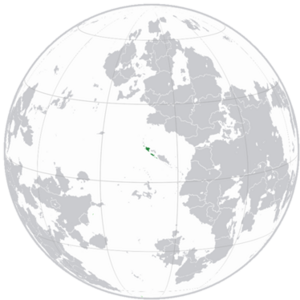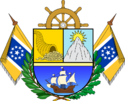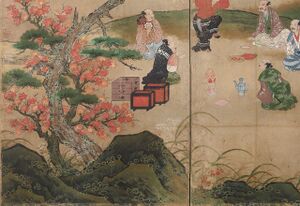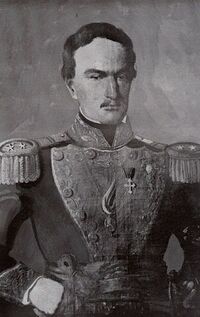Laguaira
This article is incomplete because it is pending further input from participants, or it is a work-in-progress by one author. Please comment on this article's talk page to share your input, comments and questions. Note: To contribute to this article, you may need to seek help from the author(s) of this page. |
Maritime and Salazarian Republic of Laguaira
| |
|---|---|
| Motto: "En el mar se encuentra la tumba de los tiranos" "The tomb of tyrants is found in the sea" | |
| Anthem: La Novembrina | |
 Orthographic view of Laguaira in the Parthenean Coast | |
| Capital and largest city | Puerto Paraíso |
| Official languages | Spanish, Hoterallian (Regional) |
| Ethnic groups (2020)[1] | 34.1% Gavrilian
29.8% Hoteralian 24.6% Mezclao (Mixed Gavrilian, Hoteralian, Riamese and Indigenous) 7.7% Riamese 2% Indigenous 1.8% Other |
| Religion (2020)[1] | 46.5% Catholicism
28.9% Gaoism 24.6% Irreligious |
| Demonym(s) | Laguairan, Guairan
laguaireño(a) guaireño(a) |
| Government | Federal presidential republic |
• President | Rómulo Villegas |
• Vice President | Salomón Carranza |
| Legislature | National Assembly |
| Senate | |
| Chamber of Representatives | |
| Establishment | |
• Independence declared from Canter Republic | 12 November 1814 |
• Dissolution of the First Republic | 8 January 1836 |
• Gavrilian administration | 1 September 1850 |
• Independence declared from Gavrilia | 13 November 1939 |
• Current constitution | 6 July 2004 |
| Area | |
• Total | 63,360 km2 (24,460 sq mi) |
| Population | |
• 2020 census | 12,117,204 |
• Density | 191/km2 (494.7/sq mi) |
| GDP (PPP) | 2022 estimate |
• Total | $374.05 billion[2] |
• Per capita | $30.869[2] |
| GDP (nominal) | 2022 estimate |
• Total | $132.04 billion[2] |
• Per capita | $10.896 |
| Gini (2020) | 43.4[2] medium |
| HDI (2021) | 0.738[2] high |
| Currency | Salazar (Sz.) |
| Calling code | +17 |
| Internet TLD | .lg |
Laguaira, officially the Maritime and Salazarian Republic of Laguaira[3] (Spanish: República Marítima y Salazariana de la Guaira) is a transcontinental country located in the Sunadic Ocean, and between the continents of Astariax and Olivacia. Being an archipelago, the five main islands of Yutakashima, Savozuela, Sálazar, Nueva Gavrilia and Roca Helada, alongside several more minor islands and islets comprise in total a territory of 63,360 square kilometers[3], making Laguaira the third largest island nation in the Sunadic Ocean after San Calia and Litoral.
The country counts with a population of 12 million[1], of whom 2.9 million live in the capital of Puerto Paraíso[1], also Laguaira's most populous city. The country's ethnic makeup reflects its colonial past: While it is, in its majority, composed by ethnic Gavrilians, it also counts with sizeable minorities from Hoterallia and Riamo which have, along the Gavrilians, shaped the country's cities and culture. Its only official language is Spanish[3], though languages like Hoterallian[1] and Common[1] are also widely spoken, especially among the ethnic Hoterallians and Riamese.
The islands that now make up Laguaira were previously composed by numerous indigenous states, most notably the successful Guairans, of which the country's name is derived. The first mainland settlers to colonize Laguaira were the Hoterallians, though contact was disrupted and eventually permanently severed after Hoterallia's isolationist era and confrontations with the native peoples forced the Hoterallian colonists back. Later on, the chain would be colonized by the Canter Republic, from which the country declared independence. By 1836, the First Republic would be dissolved amidst infighting, corruption and internal instability, with it opting to instead aid the mainland Gavrilians in its War of Unification as a belligerent pro-Unification faction.
With sporadic and short-lived pro-independence rebellions throughout this period, Laguaira would go on as a Gavrilian territory carrying the same traditions and culture as Gavrilia's, until the beginning of the twentieth century saw the formation of a distinct Laguairan identity and increased instability. Laguaira would finally declare independence from Gavrilia in 1939 amidst economic and social uncertainty in the Gavrilian homeland.
With the Second Laguairan War of Independence causing relatively little bloodshed, the country entered an unparalleled period of peace, in an era where the world was in turmoil. The discovery of oil near the southeast of the country only aided this stability and prosperity further. However, the country suffered a debilitating but short civil war in 2002, which resulted in the country's modern 2004 constitution and the signing of the Puertofijo Pact.
The modern state of Laguaira carries traditions of navigation[4], calmness[4] and adventure[4], giving the island the nickname[5] of 'Ten Thousand Experiences'. Its crystalline waters and variety of landscapes make it a major tourism hotspot[5], industry which became even more notorious after government efforts[6] and the country's recovery from the civil war. Other major industries are oil extraction and fishing; Together with tourism, they compose 78% of the nation's revenue[2]. Emerging sectors include services and technology, making Laguaira a newly industrialized country.[7]
Etymology
The name of "Laguaira" was originally the combination of Guaira with the article 'la' (or the). The term 'Guaira' comes from one of the ancient pre-Contact countries that existed in the country, simply called Guaira. Though the few feudal Hoterallians that arrived to the island chain didn't recognize the existence of these states, opting instead to just generically referring to them as 'island people'[8] (Hoterallian: 島の人々, Shima no hitobito), the Canterians would refer to it as the Guairan Nation (Spanish: La nación Guaira) and, eventually, the 'nación' would be skipped, with the Canterians instead opting to name the territory the Province of La Guaira. Through decades of use the term and mistyping in some key national documents[9], the 'La' would become fused with 'Guaira'.
History
Pre-Contact era
Laguaira was first settled around 200,000 BCE by various groups of indigenous people hailing from what is now the modern state of San Calia. Each group landed in different islands of the Laguairan archipelago[10]; current investigations indicate the interval between discoveries of each island by these groups may have been as little as 50 years between each landing or as long as 250 years.[10] The indigenous settlers did discover the various islets that surround the islands they landed in, but no cross-island voyages took place[10], giving way for entirely different cultures in the archipelago, although all were mainly dependent on fishing for sustenance. As the various populations grew and split away, the nations frequently waged war against one another[10] until, around 7,000 BCE, five groups had solid control over each of the islands. This is where each island's distinct culture emerged; some forms of primitive democracy and republican decision-making, not so indifferent from other civilizations, were seen among the Guairan nation[10] which Laguaira derives part of its name from.
Each of these five groups near-simultaneously initiated excursions abroad by 990 AD, initiating a series of conflicts between the previously solitary groups. The thousands of years of independent living in isolated conditions created diseases that a group could have gotten natural immunity to after a few years of exposure, but to which other groups were not genetically equipped to defend against. This caused various outbreaks among the archipelago by warriors who were returning to their group and by the few peaceful merchants who interacted with others[11], sending the combined populations of around 62,000 into disarray.[11]
First Contact
Although the situation in the islands estabilized just ten years later, with the population of the islands falling to just over 8,000,[11] one year later in 1000 AD a group of feudal Hoterallians, hailing from the Ryume domain, made landfall in what is now the island of Kaiganoshima.[8] The expedition was headed by Hondou Shigetada, an affluent merchant at the time dealing in the trade of spices. Shigetada sought to discover an island which possessed spices and a more suitable ground to cultivate the ones he had. The island's tropical climate allowed a variety of previously undiscovered spices, as well as the plantation of new ones. This caused Shigetada to dub the island 'Yutakashima' (豊か島) translating to "Rich island"[8].
During this time, rumours of a new land with spices enticed even more people back in continental and insular Hoterallia, who after arriving to Yutakashima established many settlements dedicated to the spice trade. The indigenous presence in the island was weak, with numbers in the island dropping below a thousand[8]. Nevertheless, the resistance from the Quisuko nation whom inhabited the island was strong. Subsequent clashes between the feudal Hoterallians and the Quisuko people brought down the Hoterallian numbers in the island, further compounded by the presence of diseases; From 1000 to 1010, the Hoterallian population went from around 7,000 to 1,500[8].
The era of feudal Hoterallians in the island ended with the death of Shigetada as a result of a Quisuko raid on the main Hoterallian settlement of 'Kinminato' (金港). This, compounded with a newly-installed policy of isolationism in mainland Hoterallia, caused the settlers to abandon the island and go back to the Ryume domain.
Canterian Occupation
Six centuries passed from the departure of the feudal Hoterallians, until the arrival of a group of Canterian explorers: Canterian explorer and conquistador Cristóbal Almayda, along with several parties of up to 2,500 people each[12] first touched down on the biggest island of the archipelago in 1650[12]. The island was the home island of the Guairan nation, the most powerful among the indigenous nations; the main settlement of Anzótegi had a striking resemblance to the Riamese city of Savonia. Thus, Almayda named the island 'Savozuela', or roughly "Little Savonia"[12].
With the proclamation of discovery of a set of island chains, the Canterian Empire sent more men and resources to occupy the island chain. Among the 5 indigenous nations that inhabited the islands, the Canterians only recognized the Guairans as equals to them, though the two sides still waged war against each other; The battered Guairan population, whose numbers only amounted to up to 3,000, were forced to capitulate in favor of the Canterians in the 1658 Treaty of Anzótegi. Among other things, the treaty annexed the Guairan nation into the Canterian Empire and mandated for the Guairans to adapt to the Canterian way of life in exchange for benefits in regards to the newly annexed peoples' economic and political powers. The colonial capital of Puerto Paraíso soon began construction around Anzótegi; The first governor of the province was Almayda himself.
Further excursions throughout the archipelago took place; other indigenous peoples in the annexed islands didn't have the same relatively peaceful fate as the Guairans did. Since the subjugation of the Quisuko, Kororo, Chocho and Nabuaran nations proved considerably more difficult, the Canterians engaged in a significantly more violent military campaign and, upon the fall of these nations, the terms imposed on them were significantly harsher; they became a cheap labor force for the new plantations and other economic activities that were springing up in the developing economic hub of Puerto Paraíso.
Canteria's occupation of Laguaira came with a set of profound changes to the previously isolationist indigenous peoples of the archipelago. While some Canterian colonists came from the Canterian mainland from the Western side of the world, the majority came from the significantly closer colony of Gavrilia[12], thus making the emerging culture in the arts remarkably similar to that of Gavrilia. In economic terms, Puerto Paraíso quickly became an important city due to its location as a point of access to the Astariaxan and Olivacian continents and the trade that came with them. Because of this, the colony was at first managed as the Captaincy of Puerto Paraíso, in charge of managing the trade between Astariax, Olivacia, Thuadia and Thrismari, with economic activities like farming and fishing being less relevant. However, the other side of the island was less developed due to the Gochan mountain chain, which functionally split it in two, making travel significantly more difficult.
However, sea routes were soon established that went around the coast of the island of Savozuela. With this, more settlers came in and settled the other side of the Savozuelan island. Even with this increased influx of people and resources, the economic differences were stark; while the eastern side of the island enjoyed relatively high living standards[12], at least compared to other Canterian colonies at the time, the western side's living conditions were much more limited[12]; By the end of the 17th century, Puerto Paraíso became a hub for intellectuals and businesspeople with ties to the maritime transport industry[12], while the various settlements in the west (namely Alzircia, Gipunaco, Gavriliés, and Orisiras) were focused on agriculture[12].
The explosion of wealthy, educated people in Puerto Paraíso and other cities that were beginning to be formed (Puertofijo, Macibarao and Guairejos) throughout the 18th century set the bases for the Laguairan independence movement[13]. During the start and middle of the century, though, most intellectual works and literature focused on the exaltation of a new culture distinct[13] from the Gavrilian mainland, which most settlers originated from.
Independence
- ↑ 1.0 1.1 1.2 1.3 1.4 1.5 Octavo Censo Nacional de Laguaira. Laguairan Ministry of Communications (2020)
- ↑ 2.0 2.1 2.2 2.3 2.4 2.5 Aguilar, J et al. Varios Índices Económicos y Sociales de Laguaira para el año 2022 (2020)
- ↑ 3.0 3.1 3.2 Constitución Política de la República Marítima y Salazariana de la Guaira (2004)
- ↑ 4.0 4.1 4.2 Castillo, A. Un Estudio sobre el Impacto de la Insularidad de Laguaira en su Cultura (2014).
- ↑ 5.0 5.1 Torres, W. Turismo, ¿La nueva sangre de la Nación? (2019). El Guaireño
- ↑ Presidencia Salazariana de la República Marítima. El Ejecutivo anuncia inyección de Sz. 1,500,000,000 para fomentar el turismo en el país (2007). El Guaireño
- ↑ 2015 Industrialization Index of Anteria. Anterian World Assembly.
- ↑ 8.0 8.1 8.2 8.3 8.4 Gónzales, R. et al. "El impacto de la Hoteralia feudal en el Archipélago Laguaireño" (2000)
- ↑ Bolívar, S. ¿Por qué el país tiene "La" en su nombre? 25 Minutos.
- ↑ 10.0 10.1 10.2 10.3 10.4 Vargas, R. Historia Comprensiva de Laguaira antes del Contacto (1984)
- ↑ 11.0 11.1 11.2 Gallegos, P. et al. Las epidemias que devastaron a los indígenas Laguaireños (2007)
- ↑ 12.0 12.1 12.2 12.3 12.4 12.5 12.6 12.7 Martínez, L. Historia de los Canterianos en Laguaira colonial (2009)
- ↑ 13.0 13.1 López, A. Organización politico-social de Laguaira antes de la Primera Independencia de la Nación (1977)






